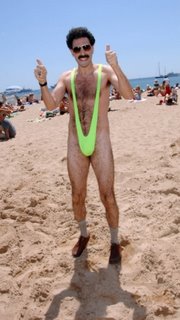
Fans of Ian Fleming’s James Bond novels know that Bond was never meant to be some pretty-boy casting off lame one-liners. He’s a badass who is so good at what he does that he is allowed to kill anyone he deems necessary. He isn’t supposed to be cute, but unfortunately the Bond movies have always leaned towards a cutesy version of Bond. This is true to some extent even in the Sean Connery movies, although he is clearly the best Bond of the bunch. Until now, that is. With “Casino Royale’s” Daniel Craig, Hollywood has finally made a Bond movie worthy of the book, and they may have found the best Bond ever.
The groundswell of fan-boy whining that greeted the announcement of Craig as the new Bond illustrates my point. The loudest complaint seemed to be that Daniel Craig is blond, and Bond is supposed to have dark hair. That people would focus on so superficial a concern shows to what extent the Bond character has been diminished in the films. For years now, Bond has just been there to show off increasingly silly gadgets and toss off cringe-inducing one-liners. The show always gets stolen by whatever larger-than-life villain the screen-writers piece together. That’s why fans grew to care so much how Bond looks. He has become nothing more than a model. It’s no wonder fans were so excited to finally see Pierce Brosnan play Bond; he looks so handsome in a tux.
Well, Daniel Craig looks good in a tux, too. He also looks like someone who would kick your ass if you got in his way. Maybe even kill you. Which brings us back to that license to kill thing. “Casino Royale” is set in 2006, but it portrays James Bond at the start of his career as 007. This Bond looks just like what James Bond probably is: a resourceful, former Special Forces soldier who uses his license to kill with cold precision.
The story of “Casino Royale” involves an international banker who specializes in servicing terrorists, warlords, and the like. This banker, who calls himself Le Chiffre (French for “the figure” Other translations include “the number” or “the cipher”), tends to use his clients’ money for high-risk, high-profit investments, which is how he ends up in a high-stakes ($100 million) poker game. (In the book, it was some French casino game called chemin de fer, but for today’s audiences, the filmmakers decided on Texas hold-em.) Bond, who is apparently known as a good gambler, is sent to play and beat Le Chiffre, thus bankrupting the banker and forcing him to flee his terrorist clients, right into the arms of England’s witness protection program. Hot poker action ensues.
Speaking of hot action, we might as well get to the Bond girls. Apparently the British government trusts James Bond with a license to kill, but they don’t trust him to carry a suitcase full of money to a poker game. To carry the case for him and provide backup they send a 110 pound 23-year-old girl. God, I love Bond movies! As Vesper Lynd, Eva Green is a fine Bond girl. She wears a ridiculous amount of eye makeup in some scenes, but she has nice tits, so we’ll call it even. For extra eye candy, they also have Bond hook up with a smokin-hot Italian actress (Caterina Murino). The obligatory bad girl (Ivana Milicevic) is Le Chiffre’s girlfriend, but she doesn’t do much in this film. Not the most memorable bunch of Bond girls, but they get the job done. Judi Dench, on the other hand, continues to shine as Bond’s boss, “M”. I like the way “Casino Royale” showcases her as something of a mentor to Bond in his early spy years.
“Casino Royale” is the best Bond experience I have had in a long time. It has great action, hot babes, good acting, and a hard-boiled edge that I think Bond films have been lacking. I’m going to have to re-watch some of those early movies, because (Connery fans, cover your eyes.) I am tempted to call this the best Bond movie ever.
4.5 stars out of 5




